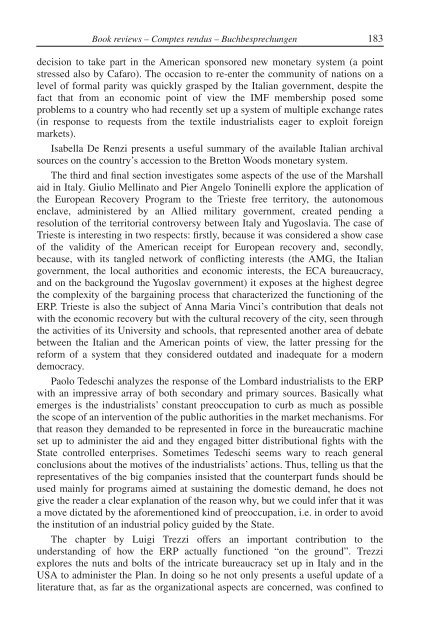2008, Volume 14, N°2 - Centre d'études et de recherches ...
2008, Volume 14, N°2 - Centre d'études et de recherches ...
2008, Volume 14, N°2 - Centre d'études et de recherches ...
You also want an ePaper? Increase the reach of your titles
YUMPU automatically turns print PDFs into web optimized ePapers that Google loves.
Book reviews – Comptes rendus – Buchbesprechungen 183<br />
<strong>de</strong>cision to take part in the American sponsored new mon<strong>et</strong>ary system (a point<br />
stressed also by Cafaro). The occasion to re-enter the community of nations on a<br />
level of formal parity was quickly grasped by the Italian government, <strong>de</strong>spite the<br />
fact that from an economic point of view the IMF membership posed some<br />
problems to a country who had recently s<strong>et</strong> up a system of multiple exchange rates<br />
(in response to requests from the textile industrialists eager to exploit foreign<br />
mark<strong>et</strong>s).<br />
Isabella De Renzi presents a useful summary of the available Italian archival<br />
sources on the country’s accession to the Br<strong>et</strong>ton Woods mon<strong>et</strong>ary system.<br />
The third and final section investigates some aspects of the use of the Marshall<br />
aid in Italy. Giulio Mellinato and Pier Angelo Toninelli explore the application of<br />
the European Recovery Program to the Trieste free territory, the autonomous<br />
enclave, administered by an Allied military government, created pending a<br />
resolution of the territorial controversy b<strong>et</strong>ween Italy and Yugoslavia. The case of<br />
Trieste is interesting in two respects: firstly, because it was consi<strong>de</strong>red a show case<br />
of the validity of the American receipt for European recovery and, secondly,<br />
because, with its tangled n<strong>et</strong>work of conflicting interests (the AMG, the Italian<br />
government, the local authorities and economic interests, the ECA bureaucracy,<br />
and on the background the Yugoslav government) it exposes at the highest <strong>de</strong>gree<br />
the complexity of the bargaining process that characterized the functioning of the<br />
ERP. Trieste is also the subject of Anna Maria Vinci’s contribution that <strong>de</strong>als not<br />
with the economic recovery but with the cultural recovery of the city, seen through<br />
the activities of its University and schools, that represented another area of <strong>de</strong>bate<br />
b<strong>et</strong>ween the Italian and the American points of view, the latter pressing for the<br />
reform of a system that they consi<strong>de</strong>red outdated and ina<strong>de</strong>quate for a mo<strong>de</strong>rn<br />
<strong>de</strong>mocracy.<br />
Paolo Te<strong>de</strong>schi analyzes the response of the Lombard industrialists to the ERP<br />
with an impressive array of both secondary and primary sources. Basically what<br />
emerges is the industrialists’ constant preoccupation to curb as much as possible<br />
the scope of an intervention of the public authorities in the mark<strong>et</strong> mechanisms. For<br />
that reason they <strong>de</strong>man<strong>de</strong>d to be represented in force in the bureaucratic machine<br />
s<strong>et</strong> up to administer the aid and they engaged bitter distributional fights with the<br />
State controlled enterprises. Som<strong>et</strong>imes Te<strong>de</strong>schi seems wary to reach general<br />
conclusions about the motives of the industrialists’ actions. Thus, telling us that the<br />
representatives of the big companies insisted that the counterpart funds should be<br />
used mainly for programs aimed at sustaining the domestic <strong>de</strong>mand, he does not<br />
give the rea<strong>de</strong>r a clear explanation of the reason why, but we could infer that it was<br />
a move dictated by the aforementioned kind of preoccupation, i.e. in or<strong>de</strong>r to avoid<br />
the institution of an industrial policy gui<strong>de</strong>d by the State.<br />
The chapter by Luigi Trezzi offers an important contribution to the<br />
un<strong>de</strong>rstanding of how the ERP actually functioned “on the ground”. Trezzi<br />
explores the nuts and bolts of the intricate bureaucracy s<strong>et</strong> up in Italy and in the<br />
USA to administer the Plan. In doing so he not only presents a useful update of a<br />
literature that, as far as the organizational aspects are concerned, was confined to

















